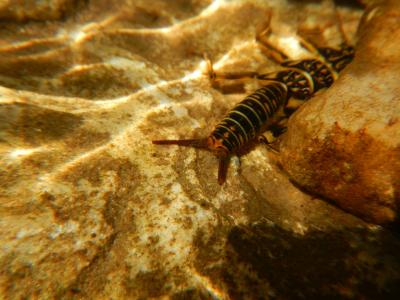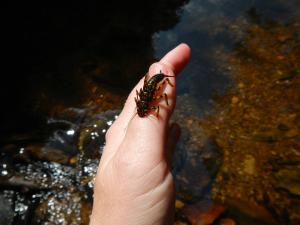Many people have seen flies of various types near creeks and rivers. If you like fishing, you may recognize some of these names: mayflies, stoneflies, caddisflies, dragonflies and dobsonflies.
Did you know that these critters are needed for the ecosystem? Most of these flies begin their life cycles in the stream and are food for fish. As a group, they are called benthic macroinvertebrates.
Benthic refers to living on the bottom of a waterbody, macro means large enough to see with the naked eye and invertebrate refers to animals without backbones. Not all benthic macroinvertebrates are insects; some other types of macroinvertebrates are mussels, clams, snails, crayfish, bloodworms and leeches. Macroinvertebrates are an important part of the stream environment.
 When a leaf falls into a stream, it begins to decompose. Most of the nutrients in the leaf are dissolved (leached) within the first few hours. Over the first few days, fungi and bacteria colonize the leaf. Several types of macroinvertebrates consume bite-size chunks and digest the fungi and bacteria off the outside of the leaf.
When a leaf falls into a stream, it begins to decompose. Most of the nutrients in the leaf are dissolved (leached) within the first few hours. Over the first few days, fungi and bacteria colonize the leaf. Several types of macroinvertebrates consume bite-size chunks and digest the fungi and bacteria off the outside of the leaf.
The leaf is broken into smaller pieces as it passes through the guts of these organisms and is released as feces into the stream. The feces break apart and the tiny leaf fragments are recolonized by more bacteria and fungi which become food for another group of invertebrates that have special adaptations to strain food fragments from the water.
The leaves continue to be broken down in this way as they are carried downstream with the stream current. Although the process is the same, the particular rate of leaf decomposition in streams varies greatly among species of leaves.
Nutrients provided by streamside vegetation are important for stimulating the aquatic food web and overall productivity of a stream. It is, therefore, important to protect vegetated areas along the banks in order to maintain stream health.
Invasive plants, like Privet, can have waxier leaves than a native so it can take a lot longer to break down in the environment. This could really affect the food web if the invasive plant became a monoculture near the stream.
The presence or absence of several types of benthic macroinvertebrates is one of the best ways to assess the level of human disturbance and pollution in streams and rivers. Each species has unique characteristics regarding habitat requirements, life history, behavior and pollution tolerance.
Macroinvertebrates are easy to collect and identify using inexpensive equipment and simple identification keys making the method safe, fun and cost-effective. They are very abundant in healthy streams and may practically cover the bottom.
Hundreds or even thousands of them can live within one square meter of substrate. Many may be seen just by looking on or under stones, sticks and leaves in the stream.
Benthic macroinvertebrates spend most of their lives in the same general stream location and are exposed to the water-quality conditions at that location over a long period of time. They generally do not relocate even when conditions are poor.
 What I love about looking for macroinvertebrates is that anyone can learn to look for them. They really have neat adaptations to learn about as well. Stoneflies have gills on their belly. When there isn't enough oxygen they will get on a rock and do push ups.
What I love about looking for macroinvertebrates is that anyone can learn to look for them. They really have neat adaptations to learn about as well. Stoneflies have gills on their belly. When there isn't enough oxygen they will get on a rock and do push ups.
Pictured here is a Stonefly I found in a creek at Julian Price Memorial Park (near Blowing Rock).
Want to learn more? Watch for the terms 'creek crawl' or 'streamside shuffle' when trying to find a citizen science activity near you.
Wendi Hartup, PEA's 2014 Volunteer of the Year, has worked for NC Cooperative Extension in Forsyth County since 2005. She educates citizens on environmental issues, wildlife control and solutions to stormwater runoff. You may find Wendi in a local creek looking for indicator organisms, instructing how to fix erosion with a rain garden, identifying aquatic weeds or advising how to get rid of creepy crawlies. Prior to Extension, Wendi spent 9 years teaching Alabama citizens how to evaluate physical, chemical and biological characteristics of water. Wendi has an M.S. in Fisheries Conservation from Auburn University and a B.S. in Marine Biology from Troy University. To learn more about Wendi and her work contact her at wendi_hartup@ncsu.edu.